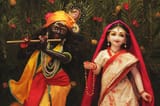Search Results
7/9/2025, 1:09:45 PM
>>17827106
>From Proto-Indo-Iranian *kr̥šnás (“black”), from Proto-Indo-European *kr̥snós (“black”).
>From *kers- + *-nós or *ker-s- + *-nós. Compare Proto-Celtic *dusnos (“dark, brown”) (see also *dubus (“black”) and *dubnos (“deep; world”))
>Possibly related words:
>Lithuanian kéršas (“with black/white spots/patches”), kéršė (“pied cow”) and kiršlỹs (“grayling”)
>Swedish harr (“grayling”) < Proto-
>Germanic *harzuz. See also Proto-Finnic *harjus (“grayling”)
>Bulgarian чep (čer, “black”) < *чepх (*čerh) like вeт (vet) < вeтх (veth), if not shortened from чepeн (čeren, “black”)
>In 3+2 anthroponyms: Thracian *kersas.
>River name: Hungarian Körös (“Criș”), Fekete-körös (“Crișul Negru”)
>Probably unrelated to Proto-Turkic *kara (“black”) and other similar words
>Krishna is represented in the Indian traditions in many ways, but with some common features. His iconography typically depicts him with black, dark, or blue skin, like Vishnu. But ancient and medieval reliefs and stone-based arts depict him in the natural color of the material out of which he is formed, both in India and in southeast Asia. In some texts, his skin is poetically described as the color of Jambul (Jamun, a purple-colored fruit)
>From Proto-Indo-Iranian *kr̥šnás (“black”), from Proto-Indo-European *kr̥snós (“black”).
>From *kers- + *-nós or *ker-s- + *-nós. Compare Proto-Celtic *dusnos (“dark, brown”) (see also *dubus (“black”) and *dubnos (“deep; world”))
>Possibly related words:
>Lithuanian kéršas (“with black/white spots/patches”), kéršė (“pied cow”) and kiršlỹs (“grayling”)
>Swedish harr (“grayling”) < Proto-
>Germanic *harzuz. See also Proto-Finnic *harjus (“grayling”)
>Bulgarian чep (čer, “black”) < *чepх (*čerh) like вeт (vet) < вeтх (veth), if not shortened from чepeн (čeren, “black”)
>In 3+2 anthroponyms: Thracian *kersas.
>River name: Hungarian Körös (“Criș”), Fekete-körös (“Crișul Negru”)
>Probably unrelated to Proto-Turkic *kara (“black”) and other similar words
>Krishna is represented in the Indian traditions in many ways, but with some common features. His iconography typically depicts him with black, dark, or blue skin, like Vishnu. But ancient and medieval reliefs and stone-based arts depict him in the natural color of the material out of which he is formed, both in India and in southeast Asia. In some texts, his skin is poetically described as the color of Jambul (Jamun, a purple-colored fruit)
Page 1
